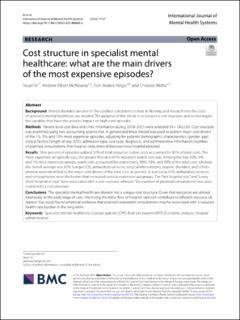| dc.description.abstract | Background:
Mental disorders are one of the costliest conditions to treat in Norway, and research into the costs of specialist mental healthcare are needed. The purpose of this article is to present a cost structure and to investigate the variables that have the greatest impact on high-cost episodes.
Methods:
Patient-level cost data and clinic information during 2018–2021 were analyzed (N = 180,220). Cost structure was examined using two accounting approaches. A generalized linear model was used to explain major cost drivers of the 1%, 5%, and 10% most expensive episodes, adjusting for patients’ demographic characteristics [gender, age], clinical factors [length of stay (LOS), admission type, care type, diagnosis], and administrative information [number of planned consultations, first hospital visits, interval between two hospital episode].
Results:
One percent of episodes utilized 57% of total resources. Labor costs accounted for 87% of total costs. The more expensive an episode was, the greater the ratio of the inpatient (ward) cost was. Among the top-10%, 5%, and 1% most expensive groups, ward costs accounted for, respectively, 89%, 93%, and 99% of the total cost, whereas the overall average was 67%. Longer LOS, ambulatory services, surgical interventions, organic disorders, and schizophrenia were identified as the major cost drivers of the total cost, in general. In particular, LOS, ambulatory services, and schizophrenia were the factors that increased costs in expensive subgroups. The “first hospital visit” and “a very short hospital re-visit” were associated with a cost increase, whereas “the number of planned consultations” was associated with a cost decrease.
Conclusions:
The specialist mental healthcare division has a unique cost structure. Given that resources are utilized intensively at the early stage of care, improving the initial flow of hospital care can contribute to efficient resource utilization. Our study found empirical evidence that planned outpatient consultations may be associated with a reduced health care burden in the long-term. | en_US |

